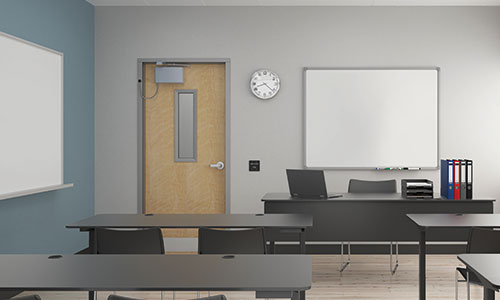By Brad Sweet
While hopes of a “normal” semester seemed possible, we were hit with the reality that the pandemic is not over as the delta variant of the coronavirus spreads across the country. As a result, K-12 schools and higher education institutions continue to evaluate their safety protocols and explore new solutions that will keep students safe and in their classrooms through the rest of the year.
Schools began implementing solutions for healthier learning environments last year, like air filtration, masking policies and class size reduction. Another approach is limiting the need to contact high-touch surfaces like door hardware.
Think about how many interior openings students and faculty pass through each day, from vestibules and cross-corridor doors to restrooms and cafeterias. Upgrading these doors to touchless access control decreases the surfaces students and staff touch, which can help prevent the spread of COVID-19 and other illnesses.
The touchless mindset carries into higher education as well. In fact, many colleges and universities started going contactless even before the pandemic, swapping out outdated credential technologies for the convenience and security of contactless options. However, contactless credentials are just a piece of the touchless access equation. After a smart card or mobile student ID is presented for access, does that person need to grab the door pull? With a low-cost automatic door operator, students simply present credentials and wave at the actuator. Touchless access is even more popular for medium-traffic doors that don’t require credentials for entry, like auditoriums and libraries.
If you’re considering touchless access for your school or campus, federal funding can help. Elementary & Secondary School Emergency Relief Fund (ESSER) and Higher Education Emergency Relief Fund (HEERF) can both be used to create healthy educational environments.
Here are 10 doors that could benefit from touchless access in a school or on campus:
- Restrooms
- Classrooms, lecture halls and auditoriums
- Shared spaces in residence halls
- Computer labs and technology centers
- Cafeterias, libraries and other common areas
- Laboratories
- Art studios and practice spaces
- Athletic spaces
- Faculty lounges
- Offices and meeting rooms
An automatic door operator designed for today’s challenges
The most common solution is to pair a low-energy automatic door operator with a no-touch actuator. LCN, the trusted name in door controls, just released an automatic operator that makes touchless access more attainable, even on mechanical doors. It’s a simple, affordable way to automate openings in educational settings.
The LCN 6400 COMPACT™ Series low-energy automatic operator is a fraction of the cost of traditional operators. And it’s easy to install. The motor gearbox mounts directly onto an LCN 4040XP mechanical closer with just four screws, eliminating the need to take it off the door. With the LCN COMPACT, you can efficiently convert more doors to touchless.
Give teachers, students and staff peace of mind this fall. Find out how you can touch less and spend less.














